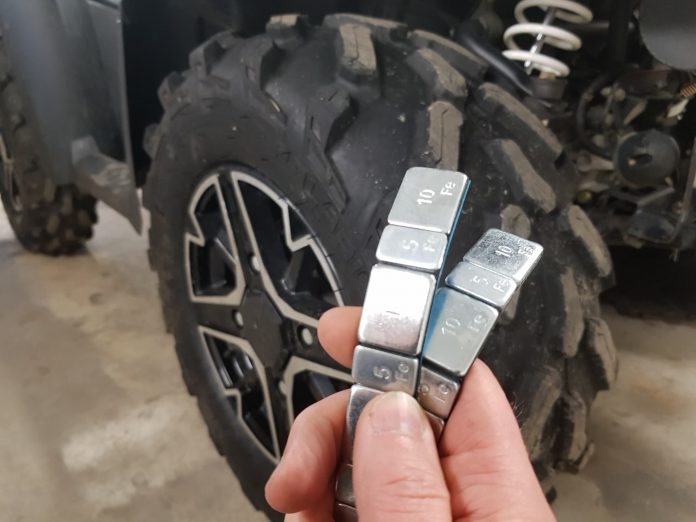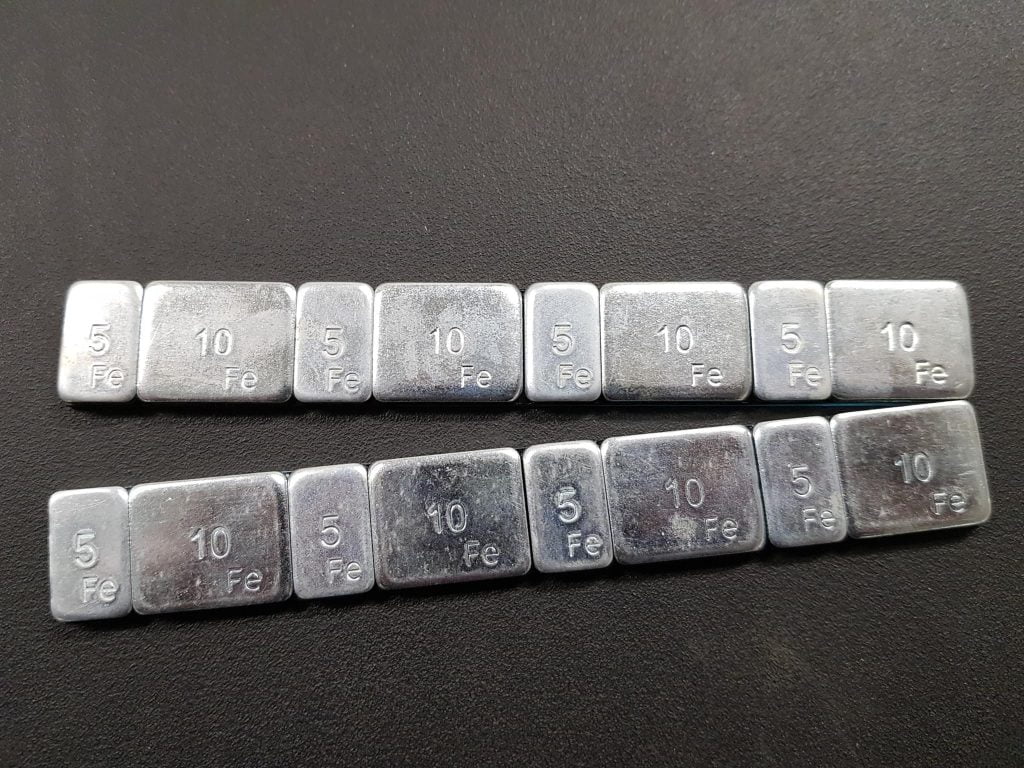In this post, we’ll look closer at the need for balancing ATV tires.
- Whether balancing ATV tires is something they do.
- Is it even possible to balance ATV tires?
- Whether you need to balance ATV tires.
- When you should balance ATV tires and when it is not required.
- And finally, what is the best way to balance ATV tires?
Do They Balance ATV Tires?
Many ATV owners are used to balancing their cars’ tires and therefore wonder if the same principles apply to ATV tires. In most unbalanced ATV tires, you will feel some degree of vibration, and this raises the question:
Do you balance ATV tires? It’s optional to balance ATV tires. Off-road and utility riding at lower speeds usually do not require a balanced tire. Aggressively threaded mud tires are hard to balance successfully. Trail riding, racing, or other higher-speed applications will benefit from balancing the tire.
The purpose of balancing any wheel is to reduce or, preferably, eliminate vibrations caused by damages or imperfections in the rim or the tire.
Any imperfection can create a heavy spot that throws the wheel off balance as it rotates. When the weight distribution is skewed, the wheel will increasingly vibrate as the speed increases.
You bring it back into balance by adding small weights on the light spot of the tire. Just enough weights are added to shift the center of gravity back to the center of the wheel.
The vibrations in some unbalanced tires are so small that it’s practically unnoticeable. At the same time, at the other end of the scale, you have tires that vibrate so much that it negatively affects the bike’s rideability.
Rider preference and what type of riding the rider does the most often determine whether he chooses to balance the tires/wheels.
Can You Even Balance an ATV Tire?
Even if you want to balance your ATV tires, can you?
Yes, you can balance an ATV tire as long as it has a removable center cap. Or at least, you can drastically reduce any vibrations that are present. However, traditional methods do not work well if you ride a lot in terrain with much mud and debris.
Some ATV steel rims have a center hole that is too large for most budget tire-balancing tools. If so, you must explore creative DIY methods or take the tire to a dealer with the appropriate tools.
What Is the Best Way to Balance ATV Tires?
There are three methods commonly used for balancing ATV tires. They are:
1. Sticky Weights and Clip-on Weights
The traditional way of balancing a tire is by adding fixed weights to the rim, so-called static balancing. Self-adhesive weights or weights clamped to the rim bead are the most common fixed weights. This method works fine on most on-road tires.
The problem with these methods for balancing ATV tires is that the weights may come loose and bring the tire back out of balance. This happens due to the rough handling these tires are exposed to compared to car tires and other on-road tires.
If you mostly ride on smooth gravel trails, paved roads, and just some occasional light off-road, you will likely have no issues using this type of weight, even if they are somewhat exposed.
Sticky weights are the most common of the two for ATVs, as they are fast and easy to use.
However, you must use weights with quality sticky tape and clean the rim with a degreaser when you install them. Otherwise, the weight might not stay put for very long.
All you need is a simple bubble balancer tool and various weights.
If you don’t want to do the balancing procedure yourself, you can ask a tire shop to do the job. Expect to pay $10-15 per tire.
But due to the well-known issue of weights coming loose from ATV tires, you may struggle to find a tire shop willing to do the job. They don’t want to deal with the hassle of losing weight complaints constantly.
Some shops even claim that ATV tires don’t fit their machine. While this may be true, it is often just an excuse so they won’t have to deal with ATV tires. Most ATV tires will fit just fine on a standard tire-changing machine.
2. Ceramic Tire Balancing Beads
Static balancing using fixed weights is generally considered better than putting a balancing medium inside the wheel.
But sticky weights may not be your best option if you ride in deep mud and on trails with rocks, dirt, sticks, and other debris. The wet soil, rocks, and debris will knock the weights off quickly.
Using so-called tire balancing beads is your best option for this kind of riding. These are tiny ball-shaped beads that go inside your tire.
As soon as the tire starts spinning, the pellets will spread out inside the tire. The beads will naturally resist the force of the heavy spot of the tire, effectively self-balancing the tire as you go.
The beads are just a few mm in diameter and are usually made from ceramic material.
You use a dedicated tool to inject the beads through your tire valve. Some, however, find this method fiddly and time-consuming.
If you know how to break the bead on your tire, it’s likely faster and easier. This way, you can pour the beads straight into the tire before reseating it to the rim.
A word of caution: Do not use tire beads combined with green slime or any other tire sealant you put inside the tire. The sticky slime will prevent the beads from spreading out properly. As a result, you may get a tire that is even more out of balance and a huge mess if you need to remove the tire to repair a leak.
Dynabeads are one brand that offers this product. Their website lists the recommended amount of beads for various ATV tire sizes. An alternative is to ask at your local truck tire shop, as tire beads are commonly used to balance semi-truck tires.
Another benefit of tire beads is that they are reusable when replacing worn-out old tires. Read this guide to learn how to change an ATV tire at home.
3. Tire Slime
Some riders use tire slime to balance their ATVs and other off-road tires. The principle of the method is called hydrodynamically balancing.
Tire slime is meant to prevent or repair leaks on all non-highway tires. Because it is liquid, it will have some balancing effect on the tire, but it is not recommended by the manufacturer or other riders that you use it for this purpose.
The slime will remain liquid for only a year or two. Once it solidifies, it will lose all balancing effects, necessitating the application of more slime.
An alternative product is the Ride-on tire sealant and balancer. This product is advertised as a sealer and a tire balancer and will stay liquid longer.
Should You, or Should You Not, Balance Your ATV Tires?
Whether you should or should not balance the tires on your ATV depends on what tire type you have, what type of riding you will be doing, and what kind of conditions you will be riding in.
It May Be a Good Idea or Necessary to Balance ATV Tires If:
- Most of your riding is at speeds above 30 MPH, on smooth trails, paved roads, or racing applications.
- You use standard-size tires with a moderate tread pattern or tires intended for on-road use.
- You regularly use large, aggressively treaded tires at higher speeds.
It May Not Be a Good Idea or Unneccecary to Balance ATV Tires If:
- Most of your riding is below 30 MPH, such as playing in the mud, technical off-road riding, rock climbing, or utility work.
- You ride a lot in mud, debris, and rocks.
- You use large, aggressively threaded mud tires at lower speeds.
Tire Type and Speed’s Effect on ATV Tire Balancing
You can get ATV tires for a wide range of riding applications, stretching from smooth and stable radial tires intended for on-road use to extreme, big-lugged mud tires.
The on-road style of tires will benefit from being balanced as they are typically used at higher speeds.
Any imbalance will become much more noticeable when the speed picks up. The stick-on weight is also more likely to stay in place, as you probably won’t ride as much in rough, muddy conditions.
Mud tires, on the other hand, are used at lower speeds for the most part. You should not have significant issues at speeds under 20-30mph, even if the tire is severely out of balance.
The oversized lugs on these tires make them unsuitable for high-speed trail riding and hard to balance. You will have difficulty keeping the weights in place, and the vibration from the big lugs is always there anyway.
Another consideration is that larger ATV tires may need months to straighten out after being banded. If you balance a new tire like this using sticky weights, you will likely have to redo the job after just a few months.
An unbalanced wheel will put a lot of extra strain on your bike’s suspension, bushings, and bearings when used at higher speeds.
The heavy lugs on mud tires worsen things, so if you plan on riding them at higher speeds now and then, a balance job may pay off down the line.
The massive lugs on mud tires can exacerbate imbalance issues. Therefore, investing in a tire-balancing job may be worthwhile if you occasionally ride at higher speeds.
Your best option for balancing a mud tire is internally balancing them using tire beads.
Riding Conditions Effect on ATV Tire Balancing
When you’re playing in the mud, it doesn’t matter that much whether the tire is in balance. Any amount of dirt in the rim will throw the tire out of balance, and no amount of weight can prevent this.
And as we’ve already discussed, sticky weights, clip-on weights, or any other type of weight mounted on the rim’s outside surface will not last long in rough riding conditions. But again, because of the low speed, this will likely not be an issue for you.
The same applies to any other type of riding where speeds are low. If you balance the wheels, you will hardly notice a difference in technical off-road riding, rock climbing, and most utility work types.
The improvement of a balanced set of wheels will only become noticeable when you ride on smooth, hard surfaces like groomed trails or paved roads. This balance not only reduces vehicle wear but also significantly enhances ride comfort.
The Bottom Line
In conclusion, the need to balance ATV tires depends on various factors such as tire type, riding style, and riding conditions. While it’s possible to balance these tires, the process might not always be necessary, especially for off-road and low-speed rides.
Traditional tire-balancing methods may face challenges with mud tires, and in certain terrains, suggesting alternatives like tire beads or DIY solutions might be preferable.
Remember that balancing tires can enhance comfort and minimize vehicle wear on smoother terrains. However, in rugged or muddy conditions, balancing may not yield noticeable benefits. Always consider your riding habits and conditions before opting for tire balancing.


